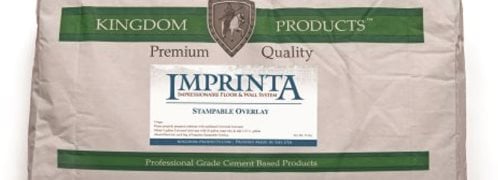- Concrete Overlays Home
- Get the Look - Interior Overlay Pictures
- When to Use a Polymer Overlay
- Comparison Chart of Overlay Systems: Which is best for your project?
- Five Factors to Consider when Choosing a Resurfacing System
- Concrete Overlay Reviews
- Types of Overlays
- Epoxy Coatings
- Microtoppings & Skim Coats
- Self-Leveling Overlays
- Spray-Down Toppings
- Polishable Overlays
- Stamped Concrete Overlays
- Preparing Concrete for Resurfacing
- Concrete Resurfacing
- Reducing Bond Failures Caused by Moisture-Vapor Transmission
- Don't Let Water Vapor Delaminate Your Overlay: How to seal concrete before an overlay
- How-To Tips for Installing Concrete Overlays
- Answers to Common Questions About Concrete Overlays: Advice from expert Chris Sullivan
- How to Add Color to Concrete Overlays
- How to Protect and Maintain Resurfaced Concrete
- Overlay Tools: Seven essential tools for concrete resurfacing
- Related Information
- Concrete Overlay Videos, with Bob Harris
- Decorative Concrete Overlays: A primer of the various overlay types and the decorative possibilities with each
- Vertical Concrete Overlays: Lightweight cement-based overlays mimic stone, brick, and other wall textures
Microtoppings - The Most Diverse of All Decorative Overlay Types
Multiple finish and color options make microtoppings ideal for a wide range of applicationsThis is an excerpt from the new e-book “Concrete Overlays Today,” part of a series of reports from ConcreteNetwork.com on trends and insights about decorative concrete applications.
Free E-book:
Concrete Stamping Today
Discover seven rising trends in the overlay industry from ConcreteNetwork.com’s new e-book. You’ll get insights and advice from veteran overlay installers that will help you find success in today’s market.
Download Concrete Overlays Today (PDF)
Microtoppings, or thin-section overlays, run the spectrum from spray deck products for driveways and pool decks to high-end trowel-grade materials for interior residential and commercial spaces. They also run the spectrum when it comes to strength. Knock-down systems can reach 3000 psi, while higher-end interior systems used in high-traffic situations can top 6000 psi. “Of all decorative overlay systems, microtoppings command the largest portion of the market,” says Terry Grimble, director of technical services for Bomanite Co.
Microtoppings also offer the most variation in regard to color and finishes. They can be applied plain, colored integrally, or be topically colored with stains and dyes. The ability to manipulate the look of a microtopping to create a wide range of finishes and colors is a big selling point. In recent years, microtoppings have grown in popularity because of their competitive price. “People are looking for the most inexpensive floor with the best look,” says Ryan Connors, owner of Modern Concrete Surfaces, Signal Hill, Calif.
This is where microtoppings excel. You can offer so much with a microtopping that it really comes down to what the client is willing to pay and how creative the applicator wants to get. “It does not matter if the job is residential or commercial. The look is what is important, and then we match the product to realize that look,” says Connors. Modern Concrete Surfaces offers a wide range of “stock finishes” but takes advantage of the flexibility of microtoppings to find products and finishes that meet the demands of their clients.
The demand for more utilitarian exterior microtoppings is also growing. The exterior microtopping market is not quite as demanding in color and unique finish, but every bit as demanding in terms of performance and weathering the elements. In the warmer Sunbelt climates, spray deck or knock-down microtopping finishes have long been popular. These are the most common finishes found around pool decks, and for exterior concrete surfaces such as driveways, walkways and patios, and they continue to grow in popularity as the technology improves and more people realize the aesthetic benefits. These types of finishes have proven themselves reliable to a point that they are now becoming more common in colder, more environmentally demanding areas. “Residential homeowners are becoming more comfortable with topping exterior concrete,” says Chris Becker, managing director of the architectural concrete division of Stockness Construction, Hugo, Minn. In his locale, microtoppings have to endure a harsh environment, so weather-resistance is one of the top factors he considers in material selection, followed by the client’s artistic demands and budget constraints.
Another application where microtoppings are establishing a niche is in the area of specialty and designer finishes, including vertical wall coverings, bathroom showers, and countertops. “The multiple colors and textures you can get with a microtopping are not achievable with regular concrete. These systems give the installer a lot more options,” says Trevor Foster, western sales manager with Miracote Products. Foster has seen a big jump in specialty applications such as showers and walls, and feels that trend will continue as more installers see what can be done with these products. The design community, in particular, is realizing the clean look that microtoppings can provide. “You can produce a large surface area without any grout lines,” says Foster. This is very attractive not only for specialty applications such as walls and vertical surfaces, but also on large commercial flooring projects.
Related information:
Microtoppings & Skim Coats
Concrete Overlays
Return to Concrete Overlays Today
 Rapid Set Skim Coat
Repairs, levels, and smooths concrete for applications.
Rapid Set Skim Coat
Repairs, levels, and smooths concrete for applications.
 Thin Micro-Topping
Produces durable surface to color or stain
Thin Micro-Topping
Produces durable surface to color or stain
 Self Leveling Overlay
Find the overlay to meet your project's needs
Self Leveling Overlay
Find the overlay to meet your project's needs
 T1000 Stampable Overlay
For use with resurfacing concrete floors and hardscapes.
T1000 Stampable Overlay
For use with resurfacing concrete floors and hardscapes.
 Kemiko® Buildable Overlay
Decorative interior or exterior resurfacing
Kemiko® Buildable Overlay
Decorative interior or exterior resurfacing
 Flooring & Coating System
Epoxy Flooring System designed for concrete
Flooring & Coating System
Epoxy Flooring System designed for concrete
 Stamped Concrete Overlay
Warm weather and cold weather formulas
Stamped Concrete Overlay
Warm weather and cold weather formulas
 Imprinta Stampable Overlay
2-component system
Imprinta Stampable Overlay
2-component system





